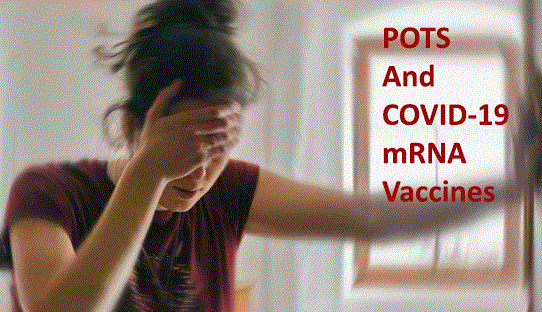Contrary To Claims That COVID-19 mRNA Jabs Protect The Vulnerable, Cedars-Sinai Study Finds That They Trigger POTS In Many With Underlying Conditions!
Nikhil Prasad Fact checked by:Thailand Medical News Team Feb 05, 2024 1 year, 2 months, 1 week, 3 days, 16 hours, 26 minutes ago
COVID-19 News: As the world grapples with the ongoing COVID-19 pandemic, vaccination efforts have played a pivotal role in reducing severe illness and mortality. However, a recent study conducted by investigators at the Smidt Heart Institute, part of Cedars-Sinai Medical Center in Los Angeles, raises concerns about a potential link between COVID-19 mRNA vaccines and the development or exacerbation of postural orthostatic tachycardia syndrome (POTS). This unexpected finding covered in this
COVID-19 News report, has prompted a closer examination of the impact of vaccination on individuals with underlying health conditions.
https://www.cedars-sinai.org/newsroom/new-study-is-there-a-link-between-covid-19-vaccination-and-pots/
 COVID-19 mRNA Jabs Trigger POTS In Many With Underlying Conditions
COVID-19 mRNA Jabs Trigger POTS In Many With Underlying Conditions
Many governments, so-called experts and garbage mainstream media disseminated the narrative that the vulnerable ie those that are aged and with underlying commodities should get the COVID-19 mRNA jabs especially those with or cardiovascular issues, hypertension and diabetes!
https://www.bhf.org.uk/informationsupport/heart-matters-magazine/news/coronavirus-and-your-health/coronavirus-vaccine-your-questions-answered#important
https://www.escardio.org/The-ESC/Press-Office/Press-releases/COVID-mRNA-vaccines-are-safe-in-patients-with-heart-failure
https://croi.ie/covid-19-advice-for-individuals-living-with-heart-disease-or-stroke/
We are now finding out that that is simply fake information and could even lead to serious outcomes due to COVID-19 mRNA vaccine induced POTs!
Background
The COVID-19 pandemic has affected millions worldwide, leading to a substantial number of hospitalizations and fatalities. The introduction of mRNA vaccines has been a crucial tool in mitigating the impact of the virus. Despite their overall safety profile, recent analyses and case reports have hinted at a potential association between mRNA vaccination and POTS. POTS is a challenging-to-diagnose heart condition characterized by an abnormal increase in heart rate after standing or sitting up.
The Cedars-Sinai Study
The groundbreaking study conducted by the Smidt Heart Institute focused on understanding the relationship between COVID-19 mRNA vaccination and POTS. Notably, the research revealed that individuals who experienced new or worsened POTS symptoms after vaccination already had preexisting conditions that heightened their susceptibility to the syndrome.
gt;
Lead researcher Dr Peng-Sheng Chen, MD, expressed surprise at the findings, stating that all patients in the study cohort possessed conditions that could predispose them to POTS, such as palpitations, fast heart rates, orthostatic intolerance, hypermobile joints, asthma, systemic lupus, fainting, and chronic abdominal pain. The study, published in the peer-reviewed journal Heart Rhythm and presented during the American Heart Association Scientific Sessions, analyzed data from 10 patients treated at the Cedars-Sinai multidisciplinary POTS clinic between July 2021 and June 2022.
https://www.sciencedirect.com/science/article/abs/pii/S1547527123027030
Results
The study findings indicated that patients with post-vaccine POTS had preexisting conditions, including previous COVID-19 infection, hypermobile Ehlers-Danlos syndrome, mast cell activation syndrome, and various autoimmune, cardiac, neurological, or gastrointestinal conditions. Importantly, the patients responded positively to guideline-directed care, suggesting that vigilant monitoring and timely intervention can improve POTS symptoms.
Heart rate variability (HRV) and skin sympathetic nerve activity (SKNA) were analyzed in comparison to a control group of 24 healthy individuals. The HRV analysis revealed a lower ambulatory root mean square of successive differences in patients with post-vaccine POTS, indicating a sympathetic dominant state. SKNA measurements also showed reduced mean amplitude and burst amplitude in these patients.
Discussion
While the study sheds light on the association between COVID-19 vaccination and POTS, it is crucial to note that the risk of developing POTS after COVID-19 infection remains higher than after vaccination.
A prior study across the Cedars-Sinai Health System found that patients diagnosed with COVID-19 were five times more likely to develop POTS after infection than after vaccination.
Dr Debbie L. Teodorescu, MD, a cardiology fellow at the Smidt Heart Institute and the first author of the study, emphasized the impact of COVID-19 infection on POTS cases, stating that the infection itself could be causing or unmasking a significant number of POTS or POTS-like conditions globally. Patients in the study responded well to treatment, but a subsequent COVID-19 infection tended to bring setbacks in recovery, highlighting the importance of avoiding COVID-19.
Conclusion
In conclusion, the Cedars-Sinai study provides valuable insights into the potential link between COVID-19 mRNA vaccines and postural orthostatic tachycardia syndrome. While the study cohort was small, the findings suggest that individuals with preexisting health conditions may be more susceptible to developing POTS after vaccination. Timely and guideline-directed care proved effective in improving symptoms, emphasizing the importance of monitoring patients with underlying health issues post-vaccination.
As vaccination efforts continue globally, ongoing research and surveillance are essential to better understand the nuances of vaccine-related complications. The Cedars-Sinai study contributes to the growing body of knowledge surrounding COVID-19 vaccination and underscores the need for a nuanced approach in monitoring and managing individuals with underlying health conditions in the post-vaccine period.
For the latest
COVID-19 News, keep on logging to Thailand Medical News.
Read Also:
https://jamanetwork.com/journals/jama/fullarticle/2800964
